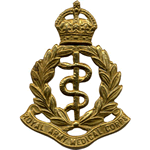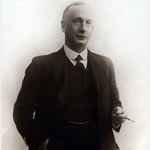Commemorated: | |||
| 1. Memorial: | Liverpool (Allerton) Cemetery | ||
| 2. Book: | The (1921) Masonic Roll of Honour 1914-1918 | Pg.131 | |
| 3. Memorial: | The (1940) Scroll - WW1 Roll of Honour | 14A GQS | |
| 4. Memorial: | Liverpool Masonic Hall War Memorial | Col.3. Hope St. | |
Awards & Titles: | Companion of the Order of the British Empire
Fellow of the Royal College of Surgeons | ||
Family :
Son of the Rev. John Carruthers and Ann Paterson, of Manchester. Husband of Beatrice Paterson, of Stainton, Menlove Avenue, Calderstones, Liverpool.Education & Career :
Medical Professor (Derby Professor of Anatomy 1894-1919).
Dean of the Medical Faculty, University of Liverpool.
Assistant Inspector of Military Orthopaedics during World War One.
See also Plarr's Lives of the Fellows - Royal College of Surgeons of England.
His name is mentioned in the book: "The Trial of Jack the Ripper: The Case of William Bury (1859-89)" by E Macpherson:
"Despite his heinous crime, Dundonians did not approve of the death penalty and William's hanging was carried out in privavy for fear of protests and rioting in the streets of the city. Early in the morning of 24 April 1889, his lifeless body was cut down from the gallows and transported to my department where the pre-eminent first Cox Professor of Anatomy (Professor Andrew Melville Paterson) taught human anatomy to his curious and diligent medical students. William Bury's body would have been of great interest to them and highly prized."
Service Life:
Campaigns:
- The First World War 1914-1918, World-wide.
| Unit / Ship / Est.: Royal Army Medical Corps |
| Action : Post War |
Post War includes all operations in all theatres up to 31st August 1921. This excludes the campaign in Russia against the Bolsheviks. It also includes men who succombed to wounds post war and who died from various causes whilst still in the services but post war.
Detail :
Andrew Melville Paterson held a commission in the RAMC, rising to Lieutenant-Colonel, working at the Orthopaedic Centre at Alder Hay, then as Assistant Inspector of Military Orthopaedics under Sir Robert Jones, he was responsible for organising medical centres, during the war. He suffered the grievous loss of his son, Lieut Paterson, at the Battle of Jutland.
During the course of his military duties he returned to Liverpool, fell ill of broncho-pneumonia, and died at 21 Abercromby Square on Feb 13th, 1919.
The British Medical Journal printed his obituary, 1st March 1919: "OBITUARY
A. M. PATERSON, M.D.EDIN., F.R.C.S.ENG., LIEUTENANT-COLONEL R.A.M.C.,
Professor of Anatomy. University of Liverpool; Assistant Inspector Special Military Surgery.
THE death of Professor Paterson, which took place rather suddenly on February 13th, has caused deep regret to all who knew him. Four days previously, in the course of his military duties, he had returned from Landon feeling indisposed; bronchopneumonia supervened, and he passed away.
Andrew Melville Paterson was born in Manchester in 1862, and was the son of a Presbyterian minister. He received his general education at Manchester Grammar School, and afterwards studied at Owens College. He graduated M.B., C.M.Edin. in 1883 with first-class honours, and in 1886 became M.D., receiving the Gold Medal for his thesis on thee spinal nervous system of mammalia. At the outset of his medical studies Professor Paterson was irresistibly attracted to anatomy. He held successively the post of a demonstrator of anatomy in the University of Edinburgh, and demonstrator of anatomy at Owens College.
In 1888 he was appointed to the newly-founded chair of anatomy in University College, Dundee, and held that post with distinction until in 1894 he was elected to the Derby chair of anatomy in the University of Liverpool, which he held at the time of his death. Under his guidance the anatomical school of the university made great progress, and the anatomical department was so greatly developed under his care that it may be described as his best memorial.
He was untiring in making complete the teaching arrangements for the subject of which he was so brilliant an exponent. As a lecturer Professor Paterson made the "dry bones of anatomy live," and as a blackboard delineator was unrivalled. Indeed, it may be said he built up the subject matter of his lectures by rapid and graphic illustration before the eyes of his hearers. A good disciplinarian, he riveted the attention of the students by his force of character and his pictorial ability, and made his lectures always interesting and attractive. Professor Paterson was dean of the medical faculty from 1896 to 1903, and he played a prominent part in the development and arrangement of the structural additions to the university. In 1903 Professor Paterson as Hunterian Professor delivered three lectures on the development and morphology of the sternum, based on the results of his own researches carried out in the midst of his multifarious duties. In 1910 he was elected a Fellow of the Royal College of Surgeons of England. He was an examiner in anatomy a-t the Universities of Oxford, Cambridge., Durham, and London, for the Indian Medical Service, and for the Conjoint Board in England. He took a great interest in the establishment of the Liverpool Dental Hospital, and as treasurer was most indefatigable in raising funds for its maintenance. He always regretted that dentistry had not remained, as the other specialties, an integral part of medicine. Professor Paterson was the author of many anatomical papers, and was a past president of the Anatomical Society, contributed to Cunningham's Text- book of Anatomy, and wrote a Manual of Embryology. At the beginning of 1917 Professor Paterson became assistant inspector of military orthopedics, and as chief of staff to Major-General Sir Robert Jones was strenuously occupied up to the time of his death A man of unbounding energy concentrated in not too strong a body, Professor Paterson could not remain inactive, and there is no doubt that his military duties hastened the end. Professor Paterson sought recreation in golf, and was a past captain of the Royal Liverpool Club.
In discussion he was forceful, a clear speaker and to the point, socially genial, and in matter in which he was deeply interested at times uncompromising in his views. The funeral service took place at Mossley Hill Ch,rek where representatives of the university, prominent citizens, and numerous friends were assembled to pay their tribute to the memory of a well spent and all too short a life. Professor Paterson leaves a widow, a son and three daughters. One Son, Lieutenant Paterson, lost his life in the battle of Jutland."
Masonic :
| Type | Lodge Name and No. | Province/District : |
|---|---|---|
| Mother : | Croxteth United Service No. 786 E.C. | West Lancashire |
Initiated | Passed | Raised |
3rd November 1911 | 5th December 1911 | 5th January 1912 |
Source :
The project globally acknowledges the following as sources of information for research across the whole database:
- The Commonwealth War Graves Commission
- The (UK) National Archives
- Ancestry.co.uk - Genealogy, Family Trees & Family History online
- ugle.org.uk - The records of the United Grand Lodge of England including the Library and Museum of Freemasonry
Additional Source:
- Founder Researchers : Paul Masters & Mike McCarthy
- Researcher : Bruce Littley

